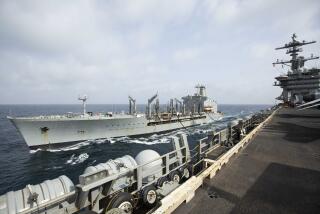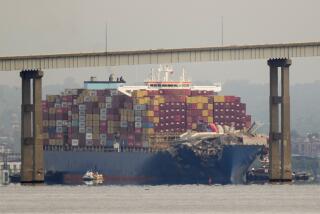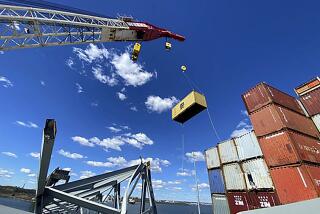Exxon Concerned as Another Plate Peels From Valdez
- Share via
A seventh steel plate has begun peeling downward from the hull of the Exxon Valdez, and officials for the first time expressed concern Friday about the ship’s seaworthiness.
Jan Cool, a spokeswoman for Exxon Shipping Co., said the weight of the plates--as much as 35 tons apiece--is causing them to pull farther away from the hull and that, at some point, that “will affect the integrity of the ship.”
Although the plates are a sort of skin on the hull and are not themselves crucial to the ship’s seaworthiness, Cool said that “one plate potentially could peel back and affect a ballast tank. If that happens, we could have serious problems keeping the ship afloat.
Verge of Agreement
“The ship now is fully operational,” she said, adding that “it would take a substantial amount” of peeling before the plate reached the ballast tank, which holds water to keep the ship stable.
The discovery late Thursday of a seventh jutting plate, about 20 feet by 48 feet, and of further peeling back of six other plates, led to the heightened concern.
Meanwhile, the state and Exxon Shipping were on the verge of reaching an agreement to allow the crippled Valdez to enter state waters. The sides had successfully negotiated two critical conditions of the oil company’s liability, a source close to the proceedings said.
Offshore, calm seas with swells up to about 2 feet allowed divers to begin cutting away some of the dangling steel plates.
Also Friday, the U. S. Coast Guard said samples collected Monday from a blue sheen sighted 10 miles south of the tanker proved to be waste water from a ship’s bilge and were not believed to have come from the Valdez.
The ship was about 7 miles northeast of Pyramid Head on San Clemente Island on Friday.
$20 Million in Security
Representatives of the state and Exxon negotiated on a state demand that the oil company post a $20-million line of credit and replaced it with an agreement that Exxon provide a $10-million surety bond, comparable to a security deposit, and a $10-million escrow account that could be used by the state for general expenses or emergency funds, a source close to the proceedings said.
“It’s still the $20-million guarantee, it’s just not quite as threatening, if you will, to Exxon,” the source said. “The basic idea of the guarantee of performance is still there.”
Another condition that had raised debate, that “no discharge of waste” from the Valdez affect state waters, was resolved Friday, but it was uncertain how that agreement was reached.
“All the points have been agreed to in concept,” the source said. “But some very fine language still needs to be worked out.”
The state also has demanded that Exxon provide several measures to prevent environmental damage to state waters and submit plans for plate removal and maneuvering.
Divers from the Portland-based Fred Devine Diving & Salvage Co., the same company that made initial repairs to the Valdez’s hull in Alaska after its huge spill there, Friday were able to attach cables to some of the plates to prevent them from falling after being cut. They also cut off a small piece of metal that had been preventing the crew from reaching one of the plates, said Cool, the spokeswoman for Exxon.
Testing the Waters
The diving team was expected to decide late Friday whether the plate removal could be done outside state waters. Since Wednesday, they have been testing the waters for possible removal of the plates, which jut down as much as 70 feet from the hull. But open-seas conditions, such as swells of up to 7 feet Thursday afternoon, have delayed the process.
“I think there’s sincere concern, not about the structural integrity of the ship, but of the status of the plates peeling away,” Cool said.
The plates, which peeled back during the vessel’s 2,200-mile trip from Prince William Sound to San Diego, prevent the ship from entering San Diego Bay, where it is scheduled to dock at National Steel & Shipbuilding Co. for a nine-month, $25-million repair job.
Coast Guard Cmdr. Don Montoro late Thursday gave Exxon permission to move the ship to within 6 miles of the coast, and Friday cleared the vessel to move to calmer waters even closer to shore. But, until the state and Exxon reach an agreement, the ship will remain outside state waters, which extend 3 miles from the coast, said Coast Guard Lt. Larry Solberg.
“Actually, the current location of the vessel is fairly protected--almost as protected as the anchorage” in state waters, Cool said.
No discharge of a bluish substance, revealed by Coast Guard tests to contain equal parts of weathered crude oil and marine life, has been seen coming from the tanker since Sunday.
Test results of samples taken from its tanks are expected within two or three days, the Coast Guard said.
The tanker was towed from Alaska after hitting a reef and causing the nation’s worst oil spill, along the Prince William Sound shoreline. The ship was scheduled to enter San Diego Bay on July 11 for repairs at Nassco, which built the vessel in 1986.
But the discovery July 10 of the jutting plates, as well as the slicks and discharges, have delayed its entry.
More to Read
Sign up for Essential California
The most important California stories and recommendations in your inbox every morning.
You may occasionally receive promotional content from the Los Angeles Times.










